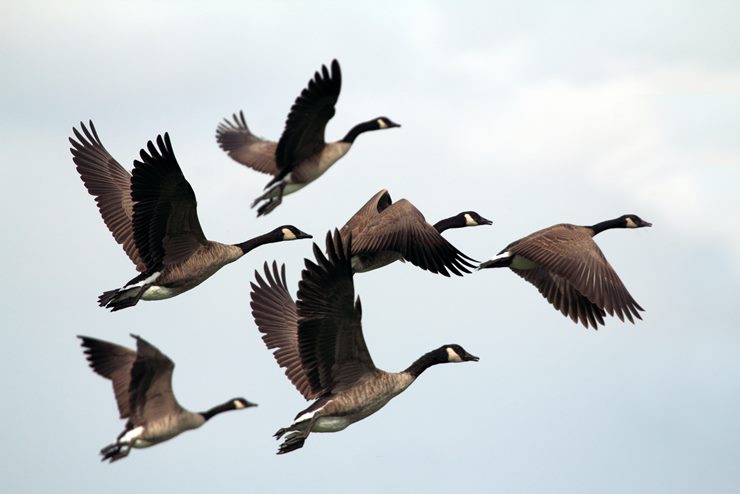Geese are waterfowl in the same family, Anatidae, as ducks and swans. Two genera of true geese comprise the goose branch of the family. True geese are generally larger than ducks but smaller than swans.
Geese often gather in groups. People commonly call a group of geese a Gaggle, presumably because of how noisy they are together. Sometimes, a group of swimming geese is called a Plump, while a group of flying geese is called a Skein.

Additional collective nouns for geese include:
- Flock
- Herd
- Swarm
- Bunch
- Knot
- Drove
- Flight
- String
- Lag
- Sute
- Gagelen
- Trip
- Sord
- Nide
- Covert
- Chevron
- Nye
- Knob
- Gagelynge
- Cluster
- Christmas
Canada geese live throughout North America. This bird was once overhunted, almost to extinction. Since then, their population has rebounded, and these birds are more common throughout their range. A group of Canada geese is called a wedge.
Geese live worldwide, on every continent except Antarctica. Snow geese live in the Arctic Region during the summers. A group of snow geese is called an Avalanche or a Blizzard.
Geese live around water on ponds, lakes, wetlands, and rivers. They feed on vegetation, such as pondweed, grasses, and grains. These birds can live for more than 25 years in the wild. The oldest goose ever holds the Guinness World Record for living for 49 years and eight months.
Table of Contents
What is a Pair of Geese Called?
Geese mate for life once they bond. Male geese court females in an elaborate dance that involves head dipping and other movements while floating on water. Ultimately, the female chooses the male based on his courtship dance and his ability to fight off other males.
Males start mating around age three, while females mate between ages three and four. Even though geese mate for life, there is no specific name for a pair of geese. If one of them dies, the other mourns that loss for a while, perhaps as long as two years.
Once geese bond and mate, the female selects a nesting location. When she finds a spot, she creates a depression in the ground and lines it with grasses, twigs, and leaves. She returns to this nesting location every year.
Male geese defend the nest aggressively from other animals, including other male geese. Before attacking, they may honk and hiss loudly while fluffing out their feathers. If the other animal does not retreat, the goose will grab onto it with its bill and beat it with its wings.
What is a Group of Baby Geese Called?
Once the female goose has built a nest, she will lay a clutch of eggs. The number of eggs in the clutch depends on the species of goose. Canada geese lay an average of five eggs, ranging from four to nine eggs each season.
The female goose incubates the eggs while the male watches over her. The eggs hatch after about four weeks. When these eggs hatch, the baby geese leave the nest within the first 24 hours and follow their parents around while they learn to forage for themselves.
These baby geese are called goslings. A group of goslings does not have a specific name. The goose parents aggressively defend their goslings for about ten to twelve weeks or until the fledgling geese can fly.
In areas where the breeding population of geese is high, and they nest relatively close to one another, the goslings may form gang broods where multiple broods of goslings follow only a few parents.
Male fledglings usually leave the parents first and flock with other single male geese. Female fledglings sometimes stay with their parents until it is time to find a mate and raise their own young.
Do Geese Flock Together in Groups?
Geese flock together for most of the year. The exception to this is during the nesting and breeding season. Mated pairs of geese go off to their nests, while unmated geese flock together. As soon as the young leave the nest, the adults sometimes return to a flock with their goslings.
During the annual migration, geese flock together in flight, making a V-formation. These birds can be seen and heard as they fly south and stop to refuel their calories along the way. In addition, geese flock during the winter, floating on open water, sometimes forming large foraging groups.
Do Geese Migrate?
Geese make an annual migration each fall and summer. Some of these migrations are long and may cover more than 1,000 miles (1,609 kilometers) in one 24-hour period. This period of migration is when geese are most vulnerable.
Geese have become adept at timing their migrations with changes in climate instead of changes in the season. This flexibility allows them to maximize the available resources within their ranges because migration is an energetically-expensive process.
Fall migrations usually happen at a slower pace than spring migrations. In the fall, geese do not have any place they need to be. In the spring, however, geese are in a hurry and may not spend as much time at their stopover sites.
Once geese reach their summer breeding grounds, they spend some time rebuilding the energy stores lost from the rapid migration north before they start courting and nesting.
The stopover sites utilized by geese during the annual migration have undergone some changes due to urbanization, development, and climate change. Researchers try to understand which sites are important so they can implement protections for these necessary stopover sites.
Other Collective Nouns for Waterfowl Family:
What is a Group of Ducks Called
What is a Group of Swan Called
